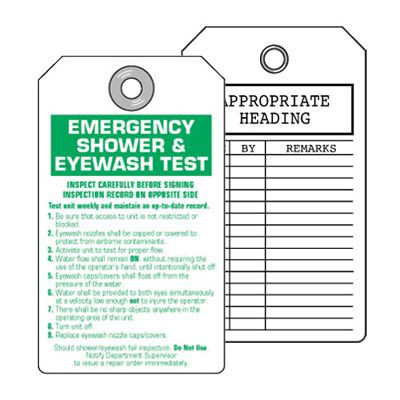Eyewash Station Inspection Template
100 feet movie free download torrent. Emergency Eyewash Station If you are responsible for conducting eyewash station checks at your facility, we recommend using an. An eyewash station checklist can have numerous benefits: • Ensure the unit is working properly in a time of crisis • Streamline the inspection process • Ensure a consistent and thorough process • Help your facility meet OSHA and ANSI standards.
As the designated safety inspector, you should be trained and/or certified in the appropriate OSHA and ANSI standards. You should also stay up-to-date with any new regulations or standards. ANSI recommends that you inspect your eyewash stations weekly. Compliance Both OSHA and ANSI have requirements for eyewash stations. OSHA is considered the enforcement agency, while ANSI sets the standards. In the case of eyewash stations, OSHA references the ANSI standard, but they do not require compliance with it. In order to meet best management practices, a good safety program will follow both the OSHA and ANSI standards.
Eyewash station operates correctly: activating arm operates smoothly and remains open when released. Water flows continuously, with each nozzle expelling water in roughly equal amounts and equal height. Report any problems to Facilities Management at 612-624-2900 Flush Record.
OSHA 1910.151(c) states the following regarding eyewash stations: That where the eyes or body of any person may be exposed to injurious corrosive materials, suitable facilities for quick drenching or flushing of the eyes and body shall be provided within the work area for immediate emergency use. OSHA further elaborates on the work conditions that would require an eyewash station or shower in a Letter of Interpretation dated April 14, 2008. The American National Standards Institute’s emergency eyewash and equipment standard (ANSI Z358.1-2014) sets the standard for proper eyewash equipment selection, installation, operation, and maintenance. The eyewash station checklist below covers key points in the ANSI standard in the areas of operation and maintenance. The checklist assumes the unit has been properly selected and installed. Refer to the manufacturer’s guidelines if you are installing an eyewash unit yourself.
Great care should be taken when determining the distance from the hazard, any possible obstructions, such as stairs or doors, and height/accessibility requirements. Eyewash Station Maintenance Checklist Complete this weekly for each eyewash station at your facility. In order to ensure a successful eyewash program, you should conduct an annual audit to make sure all stations are in compliance. You should also audit the program any time new work hazards are introduced or relocated within your facility. Eyewash Station Training All employees must be familiar with the location and use of eyewash and safety showers, even if their job does not involve working directly with toxic or corrosive chemicals. You may be called upon to aid a fellow employee who has had an exposure. Eye and Face Protection – Eyewash Station Training Points • Hold eyelids open using the thumb and index finger to help ensure that effective rinsing has occurred behind the eyelid.
It is normal to close eyes tightly when splashed, but this will prevent water or eye solution from rinsing and washing the chemical out. • Eyelids must be held open. • Always wash from the outside edges of the eyes to the inside; this will help to avoid washing the chemicals back into the eyes or into an unaffected eye. • Water or eye solution should NOT be directly aimed onto the eyeball, but aimed at the base of the nose. • Flush eyes and eyelids with water or eye solution for a minimum of 15 minutes. • “Roll” eyes around to ensure full rinsing. • Contact lenses must be removed as soon as possible to ensure that chemicals are not trapped behind the lenses and then the eyes can be completely rinsed of any harmful chemicals.
Conclusion Weekly inspections can be conducted by maintenance, safety, or other trained personnel. Eyewash checks can also be performed by an ITU AbsorbTech certified First Aid specialist as part of their eyewash service program. This service is currently offered in Wisconsin, Illinois, Michigan, and Pennsylvania.
Please print and use the attached checklist that includes the reminders below. Flush eyewash stations(s) weekly and check for the following: • Is the water clear? • Are the jets working properly? • Is the area around the station clear of obstructions? • Is there a bucket located under the eyewash to collect runoff?
• Are there any leaks? To repair the unit, contact the Physical Plant Service Desk at: 413-545-6401, or submit an. Contact EH&S with questions at: 413-545-2682. Emergencies In an emergency, hold eyes open and flush for at least 15 minutes. CALL 911 or 413-545-2682, if an emergency arises. Related Document.
